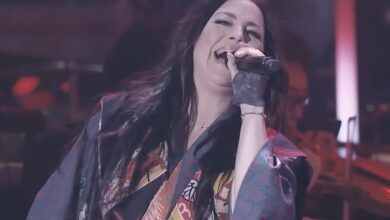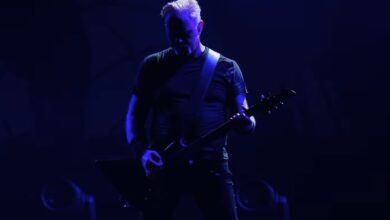Metallica Turned the National Anthem into a Roaring Rock Statement at the Stanley Cup Final
Metallica’s entry onto the ice before Game 4 of the 2016 Stanley Cup Final between the San Jose Sharks and Pittsburgh Penguins was greeted with stunned silence. Clad in Sharks-themed jerseys, James Hetfield and Kirk Hammett silently tuned their guitars, their presence alone signaling that something epic was about to happen.
Without a single lyric, the duo launched into a soaring, guitar-driven version of “The Star-Spangled Banner”—a bold, instrumental statement that rippled through the packed SAP Center, turning a routine anthem into a high-voltage moment worthy of a headline concert.
Hetfield and Hammett traded licks over each other’s leads, sculpting the familiar melody into an electrified journey. Olympic-style staccatos gave way to wailing bends, and the shifts between gentle fanfare and raw shredding became emblematic of Metallica’s ability to reinvent sonic norms—even in a hockey arena.
The audience stayed silent, awe-struck, as notes echoed off the ice walls. Family groups, die-hard fans, even the players waiting at center ice for puck drop—all paused to let the music breathe. It was an intimate, framing moment that grabbed attention before the game—and it left everyone holding their breath.
This was not Metallica’s first public anthem rendition: they had performed it before a 2015 NBA Finals game in Oakland, and at San Francisco Giants outings in prior years. But this marked their most high-profile anthem performance yet, at the Stanley Cup’s grandest stage, seen by millions across TV and stream.
The performance also resonated locally: both Hetfield and Hammett grew up steeped in Bay Area sports culture, and this was their home team’s biggest night. Their involvement wasn’t just history-making—it felt deeply personal, like a hometown tribute to home ice.
Broadcast commentators were quick to praise the anthem’s reinvention. On-air analysts described the guitars as giving the national anthem “a touch of raw electricity,” capturing both the dignity of the tradition and the adrenaline of Metallica’s signature tone.
Fans on social media erupted in praise. Many posted videos capturing the moment, hailing it as “the most metal anthem ever,” while others reflected on how this performance transcended sports, becoming a viral moment on YouTube where it still circulates as an iconic live cross-over.
It wasn’t just about volume or technical prowess—the duo’s harmonic interplay balanced chaos and control. It spoke volumes about Metallica’s decades-long evolution: even with decades onstage, they retained the power to reinvent the familiar and thrill global audiences.
Deep cuts of the performance show Hetfield’s signature Flying V guitar emblazoned with shark insignia, alongside custom amps decorated for the occasion. That visual nod wasn’t mere fan service—it was a reflection of the band’s deep Bay Area roots and their love for the team.
Hetfield paused briefly after the last chord, offering a respectful nod to the crowd before stepping away. There was no fist pump, no grand gesture—just quiet dignity. It was a reminder that even rock gods show reverence when blending worlds.
Less than a minute later, the puck dropped—and the energy they sparked at center ice carried into the game. Sharks fans roared louder, players shot harder. That anthem moment wasn’t a pre-game formality—it was a spark that lit the arena on fire.
Pittsburgh fans, too, were appreciative. Even neutral sports commentators admitted that the performance brought a charged formality and edge, transforming the anthem into a moment of shared emotion across the hockey world.
The subsequent game went to Pittsburgh, but in headlines and memories, Metallica’s performance stood out as a highlight for everyone. It reminded sports fans—and music fans—that music isn’t always reserved for concerts. It can define moments of communal emotion anywhere.
In retrospect, that anthem blew beyond its setting. It joined a lineage of iconic national-anthem renditions—like Jimi Hendrix’s guitar flares in 1969—but with its own signature: thundering guitars, communal silence, and raw heritage from one of the world’s biggest bands.
For Metallica, it was another proof point: they were—and remain—not just stadium rockers, but cultural figures capable of crossing arenas, sports seasons, and generational divides with a chord. And for hockey fans, it will always stand as the night Metallica gave “The Star-Spangled Banner” a thunderous soul.





